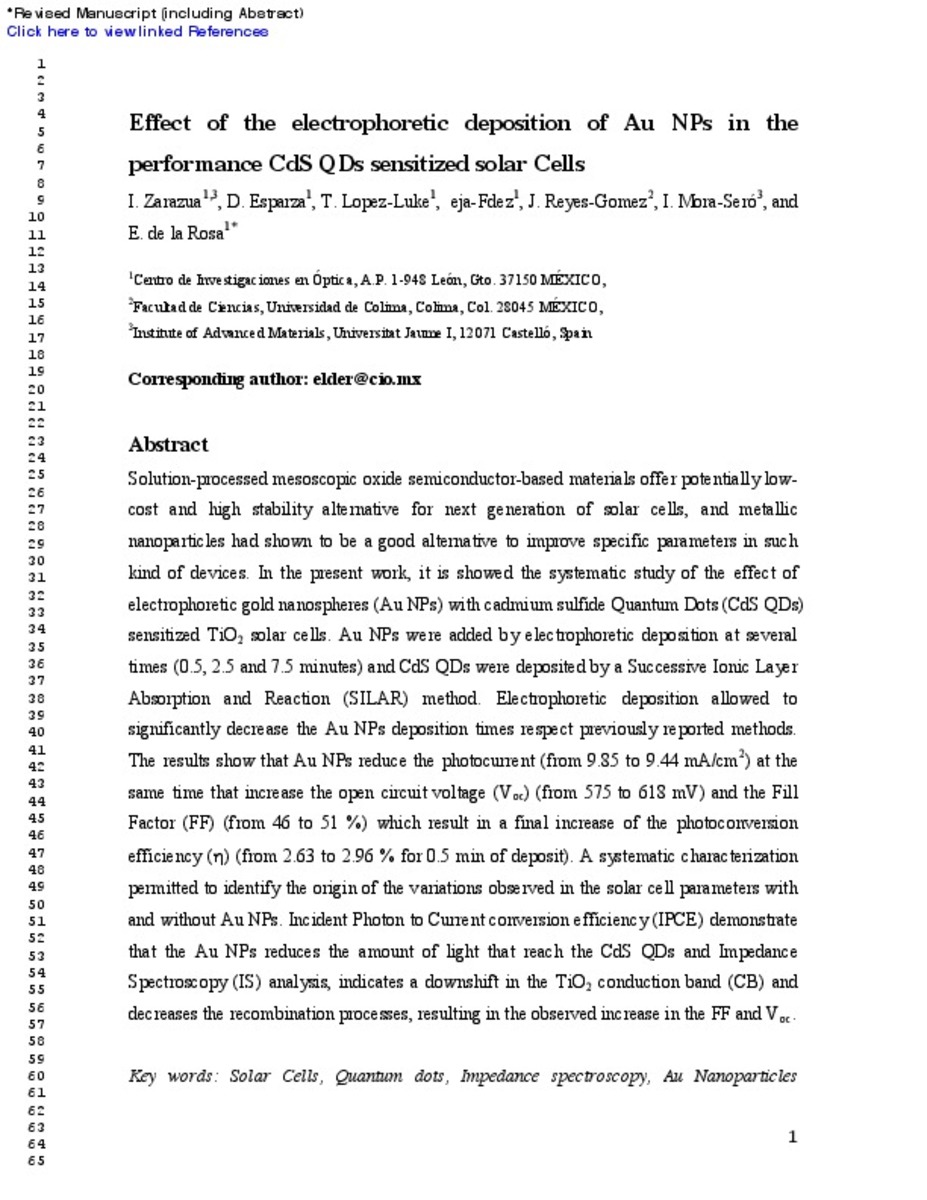Mostrar el registro sencillo del ítem
Effect of the electrophoretic deposition of Au NPs in the performance CdS QDs sensitized solar cells
| dc.contributor.author | Zarazúa, Isaac | |
| dc.contributor.author | Esparza, Diego | |
| dc.contributor.author | López-Luke, Tzarara | |
| dc.contributor.author | Ceja-Fernández, A. | |
| dc.contributor.author | Reyes-Gomez, J. | |
| dc.contributor.author | Mora-Sero, Ivan | |
| dc.contributor.author | Rosa, Elder de la | |
| dc.date.accessioned | 2016-07-04T10:15:32Z | |
| dc.date.available | 2016-07-04T10:15:32Z | |
| dc.date.issued | 2016 | |
| dc.identifier.citation | ZARAZÚA, I., et al. Effect of the electrophoretic deposition of Au NPs in the performance CdS QDs sensitized solar Cells. Electrochimica Acta, 2016, vol. 188, p. 710-717 | ca_CA |
| dc.identifier.issn | 0013-4686 | |
| dc.identifier.uri | http://hdl.handle.net/10234/161418 | |
| dc.description.abstract | Solution-processed mesoscopic oxide semiconductor-based materials offer potentially low-cost and high stability alternative for next generation of solar cells, and metallic nanoparticles had shown to be a good alternative to improve specific parameters in such kind of devices. In the present work, it is showed the systematic study of the effect of electrophoretic gold nanospheres (Au NPs) with cadmium sulfide Quantum Dots (CdS QDs) sensitized TiO2 solar cells. Au NPs were added by electrophoretic deposition at several times (0.5, 2.5 and 7.5 minutes) and CdS QDs were deposited by a Successive Ionic Layer Absorption and Reaction (SILAR) method. Electrophoretic deposition allowed to significantly decrease the Au NPs deposition times respect previously reported methods. The results show that Au NPs reduce the photocurrent (from 9.85 to 9.44 mA/cm2) at the same time that increase the open circuit voltage (Voc) (from 575 to 618 mV) and the Fill Factor (FF) (from 46 to 51%) which result in a final increase of the photoconversion efficiency (η) (from 2.63 to 2.96% for 0.5 min of deposit). A systematic characterization permitted to identify the origin of the variations observed in the solar cell parameters with and without Au NPs. Incident Photon to Current conversion efficiency (IPCE) demonstrate that the Au NPs reduces the amount of light that reach the CdS QDs and Impedance Spectroscopy (IS) analysis, indicates a downshift in the TiO2 conduction band (CB) and decreases the recombination processes, resulting in the observed increase in the FF and Voc. | ca_CA |
| dc.description.sponsorShip | We acknowledge financial support from CONACYT through grant 134111, the UC-MEXUS program grant 00007, the European Community Seven Framework Program (FP7- 428 NMP-2010-EU-MEXICO), CIO-UGTO 2013–2015 and the CEMIE-Solar (04002) consortium. D. Esparza, and A. Ceja acknowledge scholarship from CONACYT and thanks to Maria Christian Albor for SEM and EDS analysis. Isaac Zarazúa thanks to CONACYT for the postdoctoral fellow. | ca_CA |
| dc.format.extent | 34 p. | ca_CA |
| dc.format.mimetype | application/pdf | ca_CA |
| dc.language.iso | eng | ca_CA |
| dc.publisher | Elsevier | ca_CA |
| dc.rights | © Elsevier | ca_CA |
| dc.rights.uri | http://rightsstatements.org/vocab/InC/1.0/ | * |
| dc.subject | solar cells | ca_CA |
| dc.subject | quantum dots | ca_CA |
| dc.subject | impedance spectroscopy | ca_CA |
| dc.subject | Au nanoparticles | ca_CA |
| dc.title | Effect of the electrophoretic deposition of Au NPs in the performance CdS QDs sensitized solar cells | ca_CA |
| dc.type | info:eu-repo/semantics/article | ca_CA |
| dc.identifier.doi | http://dx.doi.org/10.1016/j.electacta.2015.11.127 | |
| dc.rights.accessRights | info:eu-repo/semantics/openAccess | ca_CA |
| dc.relation.publisherVersion | http://www.sciencedirect.com/science/article/pii/S0013468615309014 | ca_CA |
| dc.type.version | info:eu-repo/semantics/submittedVersion |
Ficheros en el ítem
Este ítem aparece en la(s) siguiente(s) colección(ones)
-
FCA_Articles [510]
Articles de publicacions periódiques







